Advertisements
Online Mock Tests
Chapters
2: Cell : The Unit of Life
3: Tissues : Plant and Animal Tissues
4: The Flower
5: Pollination and Fertilization
6: Seeds - Structure and Germination
7: Respiration in Plants
8: Five Kingdom Classification
9: Economic Importance of Bacteria and Fungi
10: Nutrition
11: Digestive System
12: Skeleton - Movement and Locomotion
13: Skin - "The Jack of all Trades"
▶ 14: The Respiratory System
15: Hygiene - [A Key to Healthy Life]
16: Diseases : Cause and Control
17: Aids to Health
18: Health Organisation
19: Waste Generation and Management
![Selina solutions for Concise Biology [English] Class 9 ICSE chapter 14 - The Respiratory System Selina solutions for Concise Biology [English] Class 9 ICSE chapter 14 - The Respiratory System - Shaalaa.com](/images/4567167791-concise-biology-english-class-9-icse_6:778c9d06bf3248a296d8ab25ff5c174b.jpg)
Advertisements
Solutions for Chapter 14: The Respiratory System
Below listed, you can find solutions for Chapter 14 of CISCE Selina for Concise Biology [English] Class 9 ICSE.
Selina solutions for Concise Biology [English] Class 9 ICSE 14 The Respiratory System Multiple choice type [Page 147]
During inspiration, the diaphragm
relaxes
contracts
expands
gets folded
The ultimate end parts of the respiratory system in humans are known as
alveoli
bronchioles
tracheoles
bronchi
During respiration there is
gain in dry weight
loss in dry weight
no change in dry weight
increase in the overall weight
Selina solutions for Concise Biology [English] Class 9 ICSE 14 The Respiratory System Very short answer type [Pages 147 - 148]
Choose the odd one out in the following groups of four items each:
Trachea, Bronchus, Alveolus, Diaphragm
Choose the odd one out in the following groups of four items each:
Ethyl alcohol, Carbon dioxide, Starch, Oxygen
Choose the odd one out in the following groups of four items each:
Diffusion, Respiratory gases, Alveoli, Capillary network
Choose the odd one out in the following groups of four items each:
Trachea, Ciliated epithelium, Mucous, Diffusion
Choose the odd one out in each of the following groups of four items each:
Oxyhaemoglobin, Carbaminohaemoglobin, Hypoxia, Carboxyhaemoglobin
Choose the odd one out in the following groups of four items each:
Hairy, Moist, Nostril, Vocal cord
Name the body structure concerned with the given functional activity:
Prevents food from entering the trachea during swallowing.
Name the body structure concerned with the given functional activity:
Transports oxygen to the body cells.
Name the body structure concerned with the given functional activity:
Helps to increase the volume of the chest cavity lengthwise.
Name the body structure concerned with the given functional activity:
Combines with the oxygen in the lungs.
Name the body structure concerned with the given functional activity:
Protects the lungs from mechanical injury
Name the body structure concerned with the given functional activity:
Provides actual diffusion of respiratory gases in the lungs.
What is the normal percentage composition of gases in inspired and expired air respectively?
Which chemical compound inside a cell can be termed "Currency of Energy"?
Match the items in Column I with the ones most appropriate in Column II. Rewrite the matching pairs.
|
Column I |
Column II |
|
(a) Alveoli |
(i) where aerobic respiration takes place |
|
(b) Bronchioles |
(ii) lined with hair |
|
(c) Nasal Chamber |
(iii) diffusion of gases |
|
(d) Bronchi |
(iv) small air tubes |
|
(v) an inverted Y shaped tube |
|
|
(vi) a common passage for food and air |
Selina solutions for Concise Biology [English] Class 9 ICSE 14 The Respiratory System Short answer type [Page 148]
Given below is an example of certain structure and its special functional activity:
"Kidney and excretion".
Fill in the blanks on a similar pattern.
Alveoli and _____________.
Given below is an example of certain structure and its special functional activity:
"Kidney and excretion".
Fill in the blanks on a similar pattern.
Mitochondria and _____________.
Given below is an example of certain structure and its special functional activity:
"Kidney and excretion".
Fill in the blanks on a similar pattern.
Epiglottis and _____________.
Given below is an example of a certain structure and its special functional activity:
"Kidney and excretion".
Fill in the blanks on a similar pattern.
Pleura and _____________.
Given below is an example of certain structure and its special functional activity:
"Kidney and excretion".
Fill in the blanks on a similar pattern.
Diaphragm and _____________.
Given below is an example of certain structure and its special functional activity:
"Kidney and excretion".
Fill in the blanks on a similar pattern.
'C' shaped cartilage rings and ____________.
State one function of the following:
Ciliated epithelium lining the respiratory tract
State one function of the following:
Mitochondria
State one function of the following:
Diaphragm
State one function of the following:
Intercostal muscles
State one function of the following:
Pleural fluid
Match the items in Column A with those in Column B.
|
Column A |
Column B |
|
Cartilaginous |
Epiglottis |
|
Large surface area |
Diaphragm |
|
Breathing movements |
Bronchi |
|
Voice |
Alveoli |
|
Complemental air |
Larynx |
|
Swallowing |
Extra inhalation |
Under what conditions would the breathing rate increase?
How would you prove that air you breathe out is warmer?
How is the respiratory passage kept free of dust particles?
What is wrong in the statement "We breathe in oxygen and breathe out carbon dioxide".
Selina solutions for Concise Biology [English] Class 9 ICSE 14 The Respiratory System Long answer type [Pages 148 - 149]
Differentiate between the following pairs on the basis of the aspect given in the brackets.
Aerobic and Anaerobic respiration (End products of the process)
Differentiate between the following pairs on the basis of the aspect given in the brackets.
Respiration and Photosynthesis (Gas released)
Differentiate between the following pairs on the basis of the aspect given in the brackets.
Photosynthesis and Respiration (Reactants)
Differentiate between the following pairs on the basis of the aspect given in the brackets.
Inspired air and Alveolar air (CO2 content)
Differentiate between the following pairs on the basis of the aspect given in the brackets.
Respiration and Breathing (Organs involved)
Differentiate between the following pairs on the basis of the aspect given in the brackets.
Tidal volume and Residual volume (Quantity of air)
Give Suitable Explanation for the Following :
Breathing through the nose is said to be healthier than through the mouth.
Give suitable explanation for the following :
Why does gaseous exchange continue in the lungs even during expiration?
Give suitable explanation for the following :
Why does a person feel breathlessness at higher altitudes?
Give Suitable Explanation for the Following :
Why do you shiver and why do your teeth chatter when it is very cold in winter?
With regard to the respiratory system and the process of respiration in man, answer the following questions:
Name the two muscles that help in breathing.
With regard to the respiratory system and the process of respiration in man, answer the following question:
Briefly describe how the above mentioned muscles help in the inspiration of air.
With regard to the respiratory system and the process of respiration in man, answer the following question :
Give the overall chemical equation to represent the process of respiration in humans.
With regard to the respiratory system and the process of respiration in man, answer the following question:
What is meant by :
- Residual air and
- Dead air space
Starting from the nostrils, trace the path in sequence which the inspired air takes until it reaches the air sacs.
What are the functions of the following in breathing?
Ribs
What are the functions of the following in breathing?
Diaphragm
What are the functions of the following in breathing?
Abdominal muscles
Selina solutions for Concise Biology [English] Class 9 ICSE 14 The Respiratory System Structured/Application/Skill type [Page 149]
Given alongside is a diagrammatic sketch of a kind of part in human lungs.
Name the parts numbered 1-4
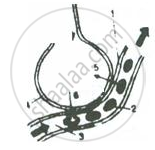
Given alongside is a diagrammatic sketch of a kind of part in human lungs.
What do the arrows 5 and 6 indicate?
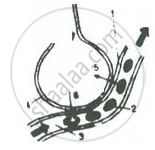
Given below is an overall chemical reaction of a certain process:
C6H12O6 →LacticAcid+2ATP+Heat energy
Name the process.
Given below is an overall chemical reaction of a certain process:
C6H12O6→LacticAcid+2ATP+Heat energy
Is this reaction applicable to animals or to plants or to both animals and plants?
Given below is an overall chemical reaction of a certain process:
C6H12O6→LacticAcid+2ATP+Heat enengy
Name one tissue in which this reaction occur.
Given below are chemical reactions (1 to 5) involving glucose and five other chemical products (A-E).
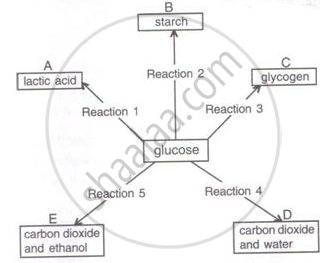
Write the reaction number of the following:
(i) Anaerobic respiration in plants __________
(ii) End products in aerobic respiration ____________
(iii) Reaction occurring in liver _________
(iv) Anaerobic respiration in animals ________
(v) Storage in the liver _________
Given below are chemical reactions (1 to 5) involving glucose and five other chemical products (A-E).
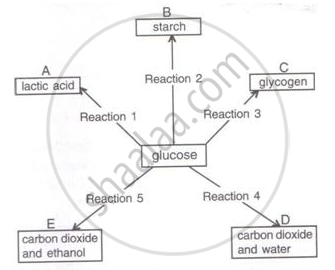
Which reactions (1-5) in the above correspond to the following (write the corresponding number of reaction next to them).
(i) Aerobic respiration
(ii) Change taking place in the liver
(iii) Anaerobic respiration in yeast
(iv) Change taking place in a plant
storage organ, e.g., potato
(v) Anaerobic respiration in animals
The volume of air in the lungs and the rate at which it is exchanged during inspiration and expiration was measured.
The following diagram shows a group of lung volumes and capacities.

Study the diagram carefully and explain briefly the following :
Tidal volume (TV)
The volume of air in the lungs and the rate at which it is exchanged during inspiration and expiration was measured.
The following diagram shows a group of the lung volumes and capacities.
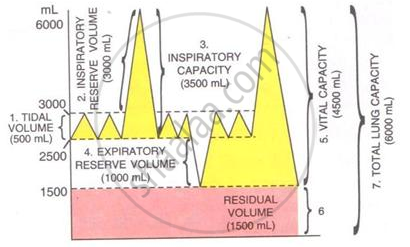
Study the diagram carefully and explain briefly the following :
Inspiratory reserve volume (IRV)
The volume of air in the lungs and the rate at which it is exchanged during inspiration and expiration was measured.
The following diagram shows a group of the lung volumes and capacities.
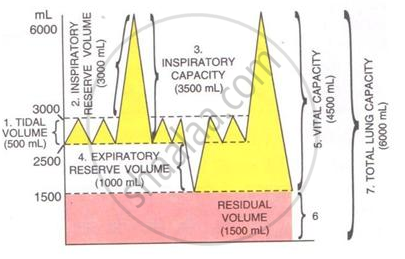
Study the diagram carefully and explain briefly the following :
Expiratory reserve volume (ERV)
The volume of air in the lungs and the rate at which it is exchanged during inspiration and expiration was measured.
The following diagram shows a group of the lung volumes and capacities.

Study the diagram carefully and explain briefly the following :
Vital capacity (VC)
The volume of air in the lungs and the rate at which it is exchanged during inspiration and expiration was measured.
The following diagram shows a group of the lung volumes and capacities.
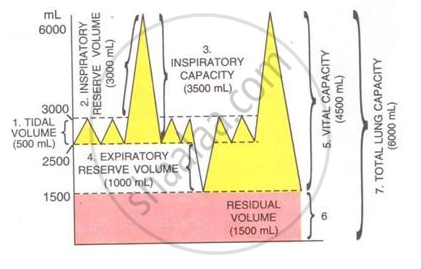
Study the diagram carefully and explain briefly the following :
Residual volume (RV)
Solutions for 14: The Respiratory System
![Selina solutions for Concise Biology [English] Class 9 ICSE chapter 14 - The Respiratory System Selina solutions for Concise Biology [English] Class 9 ICSE chapter 14 - The Respiratory System - Shaalaa.com](/images/4567167791-concise-biology-english-class-9-icse_6:778c9d06bf3248a296d8ab25ff5c174b.jpg)
Selina solutions for Concise Biology [English] Class 9 ICSE chapter 14 - The Respiratory System
Shaalaa.com has the CISCE Mathematics Concise Biology [English] Class 9 ICSE CISCE solutions in a manner that help students grasp basic concepts better and faster. The detailed, step-by-step solutions will help you understand the concepts better and clarify any confusion. Selina solutions for Mathematics Concise Biology [English] Class 9 ICSE CISCE 14 (The Respiratory System) include all questions with answers and detailed explanations. This will clear students' doubts about questions and improve their application skills while preparing for board exams.
Further, we at Shaalaa.com provide such solutions so students can prepare for written exams. Selina textbook solutions can be a core help for self-study and provide excellent self-help guidance for students.
Concepts covered in Concise Biology [English] Class 9 ICSE chapter 14 The Respiratory System are Human Respiratory System, Types of Respiration: Aerobic and Anaerobic Respiration, Parts of Respiration, Human Respiratory System, Capacities of the Lungs, Inspired Air Vs. Expired Air, Hypoxia and Asphyxiation, Experiments on Breathing and Respiration, Respiration, Formation of ATP, Mechanism of respiration-Breathing, Respiration.
Using Selina Concise Biology [English] Class 9 ICSE solutions The Respiratory System exercise by students is an easy way to prepare for the exams, as they involve solutions arranged chapter-wise and also page-wise. The questions involved in Selina Solutions are essential questions that can be asked in the final exam. Maximum CISCE Concise Biology [English] Class 9 ICSE students prefer Selina Textbook Solutions to score more in exams.
Get the free view of Chapter 14, The Respiratory System Concise Biology [English] Class 9 ICSE additional questions for Mathematics Concise Biology [English] Class 9 ICSE CISCE, and you can use Shaalaa.com to keep it handy for your exam preparation.
